GA conference 2022 report
by Peter Biles
This year marked the tenth anniversary of the Gallipoli Association’s annual conference, with around 50 members and guests meeting at the Royal Air Force Club, Piccadilly on Saturday 24 September.
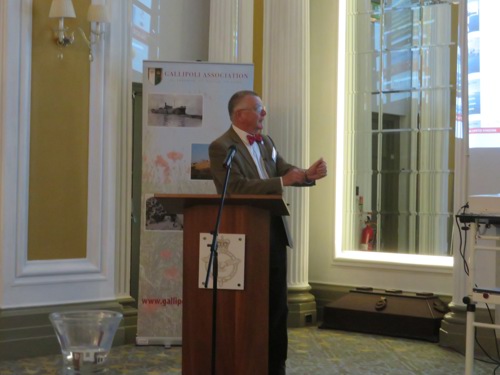
There was no better place to get started than at the geographical heart of the Gallipoli conflict. Military historian, Michael Forrest has published a definitive history of the Dardanelles Strait and his brilliant talk, The Defence of the Dardanelles: Battleships v. Coastal Defences, explored the Ottoman defences on 18 March 1915. This was the day when three battleships were lost during the abortive Allied naval attack to penetrate the crucial waterway. Michael reminded us that the Dardanelles Strait has a maximum width of seven kilometres, but at the pinch point of the narrows, the two shorelines are no more than 1200 metres apart. War Office intelligence from the 1880s had concluded that to take the Dardanelles, it would be necessary to mount a combined naval and land assault. A naval attack alone would not succeed. Old 17th century forts were an important line of defence for the Ottoman army. There was also a heavy reliance on German Krupp guns. However, in the build-up to 18 March, 403 mines had been laid, not just across the narrows, but critically in a line parallel to the Asian side of the Dardanelles. ‘The minefield was always going to be the killer’, Michael said. The French battleship, Bouvet, was sunk, as were HMS Irresistible and HMS Ocean. Michael concluded: ‘You can’t overcome coastal defences with battleships. The lesson had been there since the 1880s’.
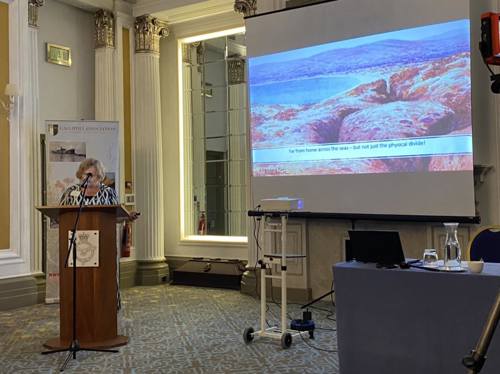
Our second presentation, Chaplains crossing the divide, was a fascinating insight into the work of chaplains of all faiths and denominations at Gallipoli, delivered by Carole Hope who has conducted extensive research during her many trips to WW1 battlefields. Her talk concentrated mainly on the Allied and English-speaking side, purely because of the wealth of accessible material. ‘Padres were never numerous at the best of times’ Carole said. ‘War Office statistics show that there were between 12 and 14 chaplains attached to each division. There was no training and no leadership on the British side. By contrast, the role of imams serving with the Ottoman forces, had long been formalised’. An important duty of chaplains was to conduct the burial service, often at night, for those killed in the fighting. Carole explained that as time went on, the chaplains took on the responsibility of writing letters of condolence to families at home. They also distributed books and stationery, gospels and helped soldiers in writing letters. The chaplains at Gallipoli faced illness, wounds and death, and Carole mentioned the case of H.C. Foster, chaplain to the Royal Naval Division, who returned home ‘with his nerves shattered’. She also highlighted the role of another chaplain, Kenneth Best, attached to the 42nd East Lancastrians, whose diaries and experiences of life under fire with the troops, resulted in the publication, ‘A Prayer for Gallipoli’.
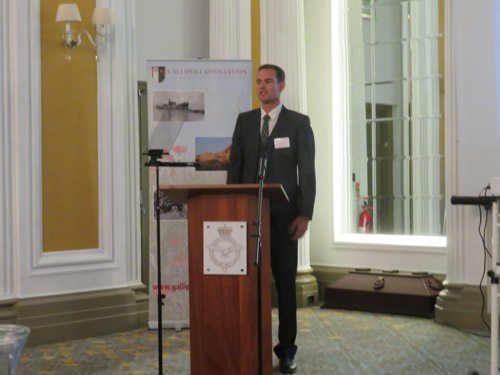
The afternoon session of the conference began in dramatic fashion with New Zealand playwright, Arthur Meek, introducing an oral adaptation of Voices of Gallipoli by the late Maurice Shadbolt. With the aid of an autocue, Arthur gave voice to a verbatim testimony from an Anzac soldier who fought at Gallipoli. The performance marked the debut of an international project to remember and honour the experiences of combat veterans by speaking their words out loud. Gallipoli Association member, Margaret Carter, said ‘Arthur brought one of my favourite books to life’, while Ian Binnie described Arthur’s performance as ‘Shakespearean’.
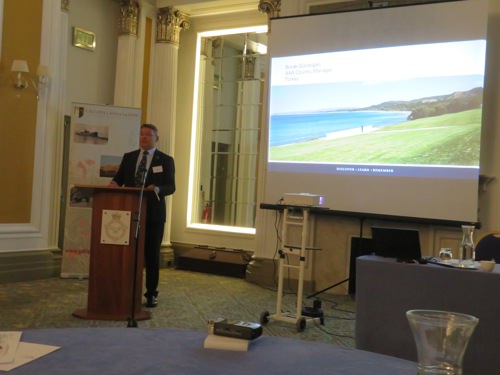
The Commonwealth War Graves Commission. Our Work Continues - Worldwide was the title of our next talk. It was an opportunity to hear first-hand from Burak Gundoğan, Country Manager in Turkey of the CWGC since 2017, the first Turkish national to be appointed to this position. Both Burak’s great-grandfathers fought at Gallipoli and lost their lives there. Operating in 23,000 locations worldwide, the CWGC now maintains more than one million headstones. The founding principal of the Commission, said Burak, was that each of the Commonwealth war dead should be commemorated by a name on a headstone or memorial. However, he added that despite the passage of time, the commemoration was not complete. Focusing on Gallipoli, Burak said a major challenge on the peninsula was the lack of water but added that Gallipoli’s 10 gardeners and four stonemasons had never stopped operations during the global pandemic.
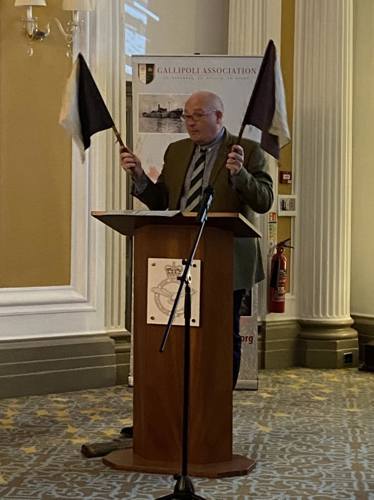
The importance of terrain and climate was also a theme of Clive Harris’ entertaining presentation ‘The War on the Wire’. The story of signalling in the Gallipoli Campaign. Clive served in the Royal Signals and has become a hugely respected battlefield guide, having led more than 60 tours to the Dardanelles. He began his talk with a surprise practical lesson using an original pair of Gallipoli signalling flags. Clive stressed that Gallipoli was complex and the communications element of the Gallipoli Campaign was an essential component to success or failure. ‘No comms, no bombs’, he said. Clive highlighted in particular, the contribution made by despatch riders, displaying photographs of them on motorcycles and also on horseback. He also noted that after WW1, some war-time despatch riders were absorbed into the Automobile Association. He referred to a number of moving accounts by signallers at Gallipoli, including Bill Leadly of the Canterbury Battalion, Harold Hinckfuss AIF and the brilliant scientist, Henry Moseley of the Royal Engineers, whose death in the war was especially costly.
This year’s Gallipoli conference, notable for the wide range of stimulating talks, closed with expressions of gratitude to the organisers, Hester Huttenbach, Tom Iredale and Stephen Chambers.
